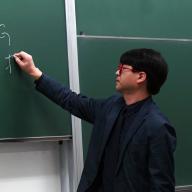About Research Themes #
Our laboratory is dedicated to uncovering the mathematical principles hidden within life’s mechanisms, pioneering a new academic field we call “Life Mathematical Science.” We strive to apply the insights gained from this approach to real-world system design, production, and control technologies, aiming to create novel systems that enrich people’s lives. Life Mathematical Science offers a new key to understanding the formation of both natural and artificial systems, serving as a driving force for improving existing technologies and generating entirely new applications. The potential of this field is limitless, and we are at the forefront, continuously challenging ourselves to pioneer its future.
The Principal Investigator (PI), Professor Inoue, holds a background in Mechanics and Statistical Physics. His research experience spans a remarkably wide range of topics, including biological morphogenesis, self-organization phenomena, collective behavior (swarm dynamics), mechanisms of robotic arms, complex fluid dynamics (rheology), novel materials development, molecular dynamics, and network structures. We highly value each student’s individual curiosity and passion – that feeling of “This is fascinating!”. Through extensive dialogue, we collaborate with you to discover and shape your own unique research theme.
We welcome individuals who can formulate their own research questions and take the initiative to actively pursue them. Undertaking highly original research inevitably involves challenges, but we are committed to fully supporting your passion and efforts. Our laboratory provides an environment where you can transform your unique ideas into tangible results and advance research that pushes the boundaries of knowledge. This is the place to conduct world-leading, one-of-a-kind research.
Examples of Past Research Themes #
Doctoral #
- Theoretical study of the enhancement of parity-violating effects in chiral molecules (PhD, 2024)
- Mathematical understanding of biological morphogenesis based on philosophical considerations (PhD, 2023)
Master’s #
- Biological shape determined by topological defects and symmetry of curvature fields (Master’s, 2024)
- Mechanical basis of folds supporting normal wing folding in pupal insects (Master’s, 2024)
- Novel cell rearrangement that does not stop tissue elongation (Master’s, 2024)
- Prediction method for intramolecular bond cleavage accompanying ionization (Master’s, 2024)
- Mathematical foundation of puzzle rule systems beyond natural language and rule generation algorithms (Master’s, 2024)
- Node stabilization theorem in Boolean Networks using graph theory (Master’s, 2023)
- Cell-centered model for understanding morphogenesis (Master’s, 2023)
- 4D printing learned from curved surface morphogenesis by differential growth in organisms (Master’s, 2023)
- Development of ion conduction path search method based on local chemical potential (Master’s, 2023)
- Relationship between spin vorticity and spin-orbit interaction in electrical conduction phenomena (Master’s, 2022)
- Mechanical simulation of mushroom-shaped formation of rhinoceros beetle horn primordium (Master’s, 2022)
- 3D simulation of spicule skeleton formation in sponges (Master’s, 2022)
- Estimation of atomic adsorption sites using local chemical potential (Master’s, 2022)
- Development of subtractive information presentation method using 2D shielding media inducing diverse interpretations (Master’s, 2022)
- Mathematical model of tissue-scale gene expression dynamics focusing on cell shape (Master’s, 2021)
- Development of genetic algorithm for linkage mechanism design (Master’s, 2021)
- Mathematical modeling of resource allocation under fishing regulations (Master’s, 2021)
- Theory of spin polarization by spin-dependent component of electron tension density (Master’s, 2021)
- Linear relationship between spin polarization rate and Zeta force in chirality-induced spin selectivity (Master’s, 2021)
Bachelor’s #
- Accuracy of numerical calculation of spin states: Evaluation using spin density equation (Bachelor’s, 2024)
- Morphogenesis through interaction between self-organization and manipulation (Bachelor’s, 2024)
- Mathematical method for introducing fold structures into curved surfaces for stiffness improvement (Bachelor’s, 2024)
- J-POP coloring the era, seen from the ’entropy’ of sound transition networks (Bachelor’s, 2024)
- Prediction of ion conduction pathways using local chemical potential based on conduction band approximation method (Bachelor’s, 2024)
- Visual expression depicting morphological growth of digital life forms using VR (Bachelor’s, 2024)
- Investigation of bending energy discretization method for cell-centered model on a sphere (Bachelor’s, 2023)
- Development of wrinkle formation method on a plane by isometric transformation of 3D objects (Bachelor’s, 2023)
- Structure estimation of Boolean networks using sparsity (Bachelor’s, 2023)
- Estimation of environmental carrying capacity in population dynamics using approximate Bayesian computation with sequential Monte Carlo methods (Bachelor’s, 2023)
- Consistency between the linear relationship equation of spin vorticity and current, and Maxwell’s equations (Bachelor’s, 2023)
- Rod element model of Bouligand structure appearing in nature (Bachelor’s, 2022)
- Mathematical considerations for automatic creation of puzzle rules (Bachelor’s, 2022)
- Wrinkle development simulation imposing local rigidity (Bachelor’s, 2022)
- Construction of a mathematical model for Drosophila wings inside the pupal case (Bachelor’s, 2022)
- Dynamics of topological defects on a torus (Bachelor’s, 2022)
- Fragmentation of amino acid molecules by ionization (Bachelor’s, 2022)
- Dimensionality reduction of Boolean networks satisfying Π(A_F) ⊂^T A_G (Bachelor’s, 2021)
- 4D print activation using shrink film (Bachelor’s, 2021)
- Extraction of scoring factors through motion analysis in ÉPÉE (fencing) (Bachelor’s, 2021)
- 3D model of rhinoceros beetle horn primordium based on micro-CT imaging (Bachelor’s, 2021)
- Intercellular network model representing 3D morphogenesis (Bachelor’s, 2021)
- Music generation using variational autoencoder with spectrograms (Bachelor’s, 2021)
- Verification of lithium-ion conduction path estimation method using local chemical potential in Li3PO4 (Bachelor’s, 2021)
